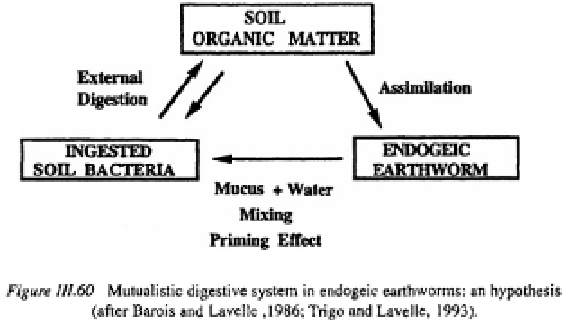Agriculture Reference
In-Depth Information
using mucus as an energy substrate. By the middle part of the gut, the mucus has been
almost completely metabolised, microbial activity is high and bacteria, through a priming
effect (see Chapter IV.1 and Jenkinson, 1966) are able to digest part of the soil organic
matter. The digestive products are released within the gut and partly reabsorbed by the
worm. This facultative symbiosis has been observed in the larvae of a number of wood
and leaf-litter feeding Diptera and Coleoptera (Campbell, 1929; Hassall and Jennings,
1975), in termites (Breznak, 1984) and temperate climate earthworms (Trigo and
Lavelle, 1993) (Figure III.60).
(iv) symbiosis between soil animals and their specific gut microflora is the ultimate
stage of an obligate association between invertebrates and micro-organisms which
permits them to digest lignocellulose. Phylogenetically 'lower' termites, have flagellate
protists and bacteria in a bulbous 'paunch' in the proctodeum. They are unique species,
found only in the gut of these termites and are attached to the gut wall by a holdfast
organelle which secures them to the epithelial tissue. These protists digest lignin by an
aerobic process and release acetate and sugars which are used by the termite
(Kirk and Farrell, 1987) (see section III.4.3.2.1). Bacteria provide growth factors for
protists, but termites can survive without these bacteria (Yamin, 1981). In higher
termites, filamentous bacteria attached to cuticular spines partly fill the proctodeal 'paunch'.
4.4.1.3
Locomotion
Three main strategies are known and are related to the sizes of the animals involved:
(i) swimming through the water films which fill soil capillaries and pores and cover
soil particles. The hydrobiont fauna moves in this way within the soil although such
movements are limited to a few millimetres, due to the small size of the animals and
the frequent discontinuity of the water phase;
(ii) movement through the air-filled pore space. This strategy is adopted by most meso-
faunal species and some slender, worm-shaped macrofauna (
e.g.,
Chilopoda Geophilidae
and some thin polyhumic earthworms). Epigeic macroinvertebrates do the same in
the leaf-litter layers; a large number of litter invertebrates shelter in the upper centimetres


